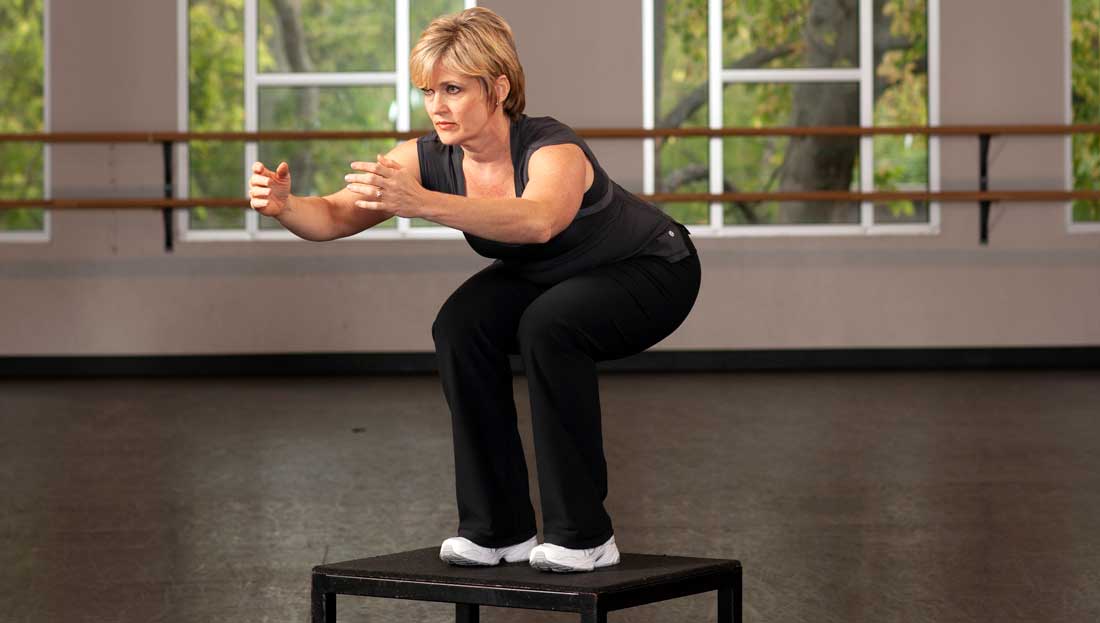
The human body is a complicated organism comprised of numerous systems responsible for producing, controlling and fueling movement. As a health and exercise professional, it is essential that you have a solid understanding of how exercise affects and initiates change to each one of these systems. Of course, as more research is conducted, and our understanding of the body expands, it can be a challenge to stay current. The body’s myofascial network, in particular, is an area of continuing study and research, but it is often overlooked or misunderstood.
To help shed some light on this fascinating, but seemingly mysterious aspect of the body, this article is part three in a series about the role that fascia plays in exercise. While Training the Fascial Network, Part 1 addressed the structural differences between muscle and fascia, Training the Fascial Network Part 2 covered how specific exercise movements can help strengthen fascia. In this third installment, we introduce new understandings from practitioners such as Thomas Myers and Robert Schleip, who have developed exercise strategies and techniques that can improve the function of fascial tissues in addition to showing how specific fascia-strengthening movements can be integrated into a comprehensive exercise program.
The Role of Muscle and Fascia in Controlling Movement
The body contains different types of cells: neural, muscular, epithelial (skin) and connective tissue, which are produced in response to specific needs for how the body is used on a regular basis (Schleip, 2015). Muscles respond to applied mechanical forces to increase the number of cells, resulting in thicker muscle fibers that react to signals from the central nervous system (CNS) to produce the physical forces responsible for movement. When a muscle receives a signal from the CNS to shorten, it creates the force to move the body; as a muscle lengthens it is reducing the forces being applied and transmitted through the body. Muscles are themselves composed of two different types of tissue: (1) the contractile element of actin and myosin cross-bridges responsible for producing or reducing force and (2) fascia, an elastic connective tissue that helps distribute the forces generated by muscle throughout the entire body. Muscle and fascia can be considered two of the most important components of hardware responsible for how the body moves in response to the signals initiated by the CNS.
Whether you are familiar with fascia or it is a brand new concept, a brief overview is worthwhile, starting with a practical definition of the term as agreed upon by delegates at the first Fascia Research Congress in 2007:
“All collagenous fibrous connective tissues that can be seen as elements of a body-wide tensional force transmission network.” (Schleip, 2015)
* Note: For the purposes of this article, the term fascia will be used to represent all elastic connective tissues that are intertwined within muscle structures.
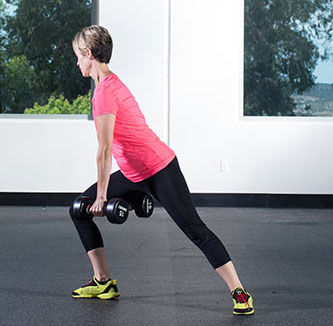 Fascia could be considered a disc drive for the body because it contains numerous sensory receptors that provide important information to the operating system (CNS) about the position and location of various structures of the body as they move. As a form of connective tissue, fascia provides protection, support and structure to the contractile element of muscle tissue, and is an important component of the tissues that make up the tendons that attach muscles to bone, ligaments that connect one bone to another and even the periosteum covering the surface of bone (Schleip, 2017). (Note: While we often perceive bone as a solid structure, keep in mind that it is living tissue in the body, and is therefore more malleable and adapts to mechanical stresses just like other tissues.) During dynamic movements, as fascia is lengthened it stores mechanical, potential energy that is released during the shortening phase of muscle action. It is estimated that fascia can return approximately 90% of energy during many movement patterns (Earls, 2014).
Fascia could be considered a disc drive for the body because it contains numerous sensory receptors that provide important information to the operating system (CNS) about the position and location of various structures of the body as they move. As a form of connective tissue, fascia provides protection, support and structure to the contractile element of muscle tissue, and is an important component of the tissues that make up the tendons that attach muscles to bone, ligaments that connect one bone to another and even the periosteum covering the surface of bone (Schleip, 2017). (Note: While we often perceive bone as a solid structure, keep in mind that it is living tissue in the body, and is therefore more malleable and adapts to mechanical stresses just like other tissues.) During dynamic movements, as fascia is lengthened it stores mechanical, potential energy that is released during the shortening phase of muscle action. It is estimated that fascia can return approximately 90% of energy during many movement patterns (Earls, 2014).
As there are two components of muscle, contractile and non-contractile fibers, there are two specific components of fascia: (1) the individual protein fibers of collagen and elastin; and (2) the extracellular matrix (ECM) containing fibroblasts, which are individual cells of fibrous connective tissue and ground substance (a gel-like substance in the extracellular space that contains all the components of the extracellular matrix except for fibrous materials such as collagen and elastin) where proteoglycans hold on to water. All cells are formed within this fluid, which plays an integral role in creating the structure of the body. The ECM surrounds individual muscle and fascia fibers like a soft, coarse mesh that contains nerve endings, sensory neurons and glands responsible for producing specific hormones (Schleip, 2017).
Collagen is a structural protein used as a building block for many tissues in body. Fascia is mostly collagen, but also contains elastin, which is a protein that lengthens in response to a tensile (lengthening) force and returns to the original resting position once the force is removed. Collagen and elastin contain fibroblasts, which are individual cells produced in response to mechanical forces that function as the construction workers of the body because they can repair damaged tissue or build new tissue, including collagen, in response to a mechanical stress (Myers, 2014).
Here are some additional important facts about fascia (Schleip, 2015):
- The average body contains between 40 and 51 pounds (18 to 23 kilograms) of fascia.
- Fascia responds to stress and strain and is constantly generating the cells for repairing or building new tissue.
- As fascia is lengthened, it stores mechanical energy, which is released as it shortens and returns to the original resting position.
- As much as 40% of muscle force is generated by the mechanical efforts of fascia.
How Force Builds Fascia
Mechanical force sends signals to initiate the production of fibroblasts to repair damaged tissues. As fibroblasts are produced, they, in turn, create new cells to help tissue withstand mechanical forces experienced on a regular basis. Moving a weight, such as a dumbbell or medicine ball, through multiple planes of motion or simply moving the body in numerous directions through the constant force of gravity results in the production of fibroblasts to increase the strength of tissues that are impacted by the mechanical forces. Lengthening the fascia applies tensile forces that ultimately stimulate the production of new fibroblasts for creating new collagen fibers to help the tissue become stronger and more capable of withstanding the lengthening forces, ultimately resulting in stronger, more injury-resistant connective tissues (Schleip, 2015).
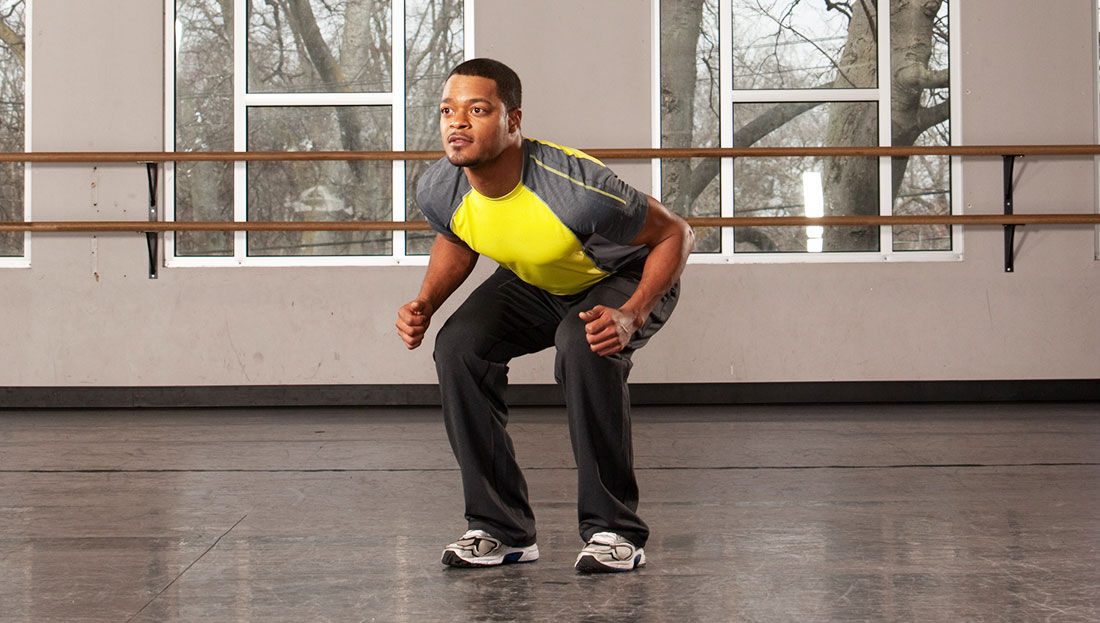 In the body, fibroblasts allow the tissues to function as a self-repairing system. When mechanical forces are applied to tissues, fibroblasts are produced to repair any damage or to create stronger fibers capable of withstanding higher levels of force. While the proper application of tensile forces can result in the adaptation of stronger connective tissue, repetitive force applied to the contractile component of muscles results in the production of fibroblasts to repair the damaged actin and myosin proteins of individual fibers, which can be one of the mechanisms of muscle growth.
In the body, fibroblasts allow the tissues to function as a self-repairing system. When mechanical forces are applied to tissues, fibroblasts are produced to repair any damage or to create stronger fibers capable of withstanding higher levels of force. While the proper application of tensile forces can result in the adaptation of stronger connective tissue, repetitive force applied to the contractile component of muscles results in the production of fibroblasts to repair the damaged actin and myosin proteins of individual fibers, which can be one of the mechanisms of muscle growth.
However, too much force from performing the same exercise too often can result in the production of fibroblasts that build proteins responsible for changing the structure of both contractile and non-contractile components of muscle. For example, a workout program that includes numerous repetitions of the chest press without proper stretching or exercises for the opposing muscle groups can result in fibroblasts producing new fibers that restrict the ability of the pectoralis major to properly lengthen and shorten during movements of the glenohumeral joint in the shoulder.
Likewise, the mechanical stress of maintaining poor posture or body position for an extended period of time results in the production of fibroblasts that create collagen fibers to strengthen the affected tissues. Muscles are organized in layers; when fibroblasts respond to the stresses imposed by poor posture, collagen is produced between the layers, which limits their ability to slide over one another during movement. An older adult with hyper-kyphosis (excessive curve of the thoracic spine) is a good example of how force initiates fibroblasts that cause the tissues in the anterior portion of the upper body to become stuck in a shortened position, while the tissue in the upper back are pulled beyond their normal resting length, resulting in an individual becoming “stuck” in a kyphotic position (Schleip, 2015; Myers, 2014).
In addition to fascia, the body contains a number of different types of connective tissue, each performing a specific function based on its placement within the body. Like fascia, each produces fibroblasts in response to any physical forces experienced on a regular basis (Schleip, 2015):
- Elastic connective tissue contains more elastin and can be found in organs such as the bladder, gall bladder, aorta and pulmonary system (which requires the lungs to expand and contract).
- Parallel, dense, fibrous connective tissues contain high amounts of collagen and include tendons, ligaments, capsules around organs and the pericardium (around the heart). The fibers are aligned parallel in the direction of applied stresses.
- Irregular, dense connective tissue consists of lower levels of ground substance, less elastin and thicker collagen bundles, and include the lining of brain and the skin, which is an organ capable of withstanding high tensile forces. The fibers are aligned in the direction of applied forces (multidirectional) and have a lower fluid content.
- Reticular connective tissue is a specific type of collagen produced in thin fibers found in the spleen, lymph nodes and fresh-healing scars.
- Special connective tissue found in adipose tissue, cartilage and the gelatinous substance of umbilical cord contain adipocytes, which store both fat and water.
Proper Hydration for Fascia
Water plays a critical role in lubricating fascia and muscle tissue, so they can achieve optimal levels of function. Because fascia can contain up to 25% of the water in the body, it is important to stay hydrated, so the various layers can slide against one another during movement (Schleip, 2015).
The ECM component of fascia contains a significant amount of water, which must stay hydrated to allow layers to properly slide during movement. In addition, if the ground substance in the ECM is not properly hydrated, it could slow down the production of new fibroblasts required for tissue repair (Myers, 2014). A lack of hydration means that instead of fascial layers sliding over one another without any friction, the ECM becomes more viscous and gluey, which causes the layers to slide more like Velcro than layers of frictionless plastic. Improper hydration, combined with remaining in sedentary positions for extended periods of time, can create the forces that result in collagen fibers forming adhesions between the layers of fascia. Finally, the amount of water in muscle tissue plays an important role in generating force during strength-training exercises. When muscle fibers contract, they push against the fluid in the ECM, thereby creating a hydraulic pressure that adds to the rigidity required for the production of a high magnitude of force (Schleip, 2017; Schleip, 2015).
One benefit of using foam rolls and roller devices is that the shear motion of the device over the tissues can move fluid through the layers of fascia, helping to improve hydration, which is necessary for optimal fibroblast production and tissue regeneration.
Exercise Strategies to Strengthen Fascia
Many traditional strength-training exercises focus on the shortening, concentric phase of muscle action and occur in a single plane of motion, which improves the ability of the contractile element to produce force. Generating muscle tension against heavy resistance can increase motor unit activation of individual muscle fibers, resulting in greater levels of force production. It is important to continue performing these exercises, because linear strength-training exercises can help improve the strength of fascia, but only in one direction—longitudinally in the direction of the force created by the contracting fibers (Findley, Chaudhry and Dhar, 2015). As the contractile element of muscle shortens, it pulls on the connective tissues at the ends of the muscle, creating a tensile force. Stronger muscle fibers are able to exert more force during muscle contraction, resulting in stronger fascia.
On the other hand, exercise programs must consider not only the contractile element of muscle that helps clients look better, but also strengthens the fascia responsible for healthy, vibrant structures throughout the entire body. Because it is comprised of collagen and elastin proteins, fascia is best strengthened when an external force is applied during the lengthening phase of muscle action. Exercises for the purpose of strengthening the fascia, which surrounds every individual muscle fiber, should be performed using lighter weights while moving in a variety of different directions. If the connective structures are loaded properly, the fibroblasts adapt their remodeling activity so that the tissue architecture responds even better to daily demands (Schleip, 2015).
Prior to the actual workout, various techniques can be employed to stimulate nerve endings in fascia to help prepare it for optimal performance during a workout:
- Using a foam roll or hand-held roller device for myofascial release creates friction between the layers of fascia, generating valuable heat to improve extensibility of all tissues, both contractile and non-contractile. (This article on foam rolling offers important insight into myofascial release techniques.)
- Weightlifters have begun using brushes (like those designed for cleaning dishes; the 3-in-1 Activator by Rollga can also be used for this purpose) to brush the surface of the skin to increase neural activity before initiating a lift. Brushing the surface of the skin is believed to improve sensory awareness of the underlying fascia. (Note: The same sensation can be created by using a traditional hard foam roller and rubbing it laterally across the line of pull of a muscle, as opposed to rolling parallel to the fiber arrangement as current myofascial release protocols suggest.) Like rolling with a hand-held roller, brushing across the line of pull of muscle fibers generates friction and heat, which is important for enhancing the ability of the various layers to slide over one another (Schleip, 2017).
- Vibration training with a Powerplate (or similar platform) can improve friction as well as activate the sensory receptors responsible for sensing length change. This, in turn, can help activate muscle motor units and improve overall muscle force output (Fieldstad et al., 2009).
When it comes to specific types of exercise, practitioner and author Robert Schleip (2017) identifies the following outcomes required to enhance the optimal performance of fascia:
- Improve extensibility, which is the ability to lengthen to achieve optimum energy storage capacity for the mechanical energy created during the lengthening phase of muscle action
- Improve the ability to lengthen in response to applied forces and return to a shortened position once those forces are removed
- Create smooth, seamless chains of tissue that function to transfer force throughout the body. Different models of fascial lines include the Anatomy Trains identified by Thomas Myers and the subsystems or slings described by Andry Vleeming.
- The rapid regeneration of fascia after the removal of a strain force can create youthful, wavy architecture of structures capable of handling loads from different directions.
Guidelines for Strengthening the Fascial Network
Exercise for the fascia should include a variety of movements in multiple directions, using multiple speeds and reaching the hands at multiple heights to increase the length of the upper-body tissues. Proper fascia loading to improve strength, specifically the ability to withstand tensile forces, should occur two to three days per week, while allowing at least 24 to 48 hours between fascial training workouts for fibroblasts to repair and build new collagens (Schleip, 2017).
- Start with small movements with a limited range of motion (ROM) and gradually build up tolerance for strain through increased ROM and movement speed.
- Like all other exercises, begin with a low repetition range to limit the amount of stress imposed upon the tissue; as the fascia adapts to the loads, gradually increase the number of repetitions.
- The ECM surrounding the fascia contains water, which is necessary for optimal function of the tissue as the layers slide over one another. Therefore, it is important to remain hydrated to allow for optimal energy storage.
- Exercises that move the arms and legs in opposite directions can use specific lines of pull to increase length and strain strength.
|
Exercise for Strengthening Fascia
The following exercises are examples of how to apply tensile forces into the body in order to increase the strength of fascia and connective tissues. Rather than engage a single muscle or body part with an exercise such as a biceps curls, strain or tensile forces should be directed through long fascial lines to engage entire chain of muscles. Rotational uppercuts challenge you to rotate to the right and flex the right shoulder under load to lengthen the triceps, which helps improve elastic storage and the ability to resist tensile forces. Yoga classes challenge participants to hold positions at the end range of motion while engaging the contractile element, which creates strain on the fascia while shortening the fibers. (Note: The second installment of this series, Training the Fascial Network, Part 2, contains additional exercises that can improve fascial strength.)
|
|
Exercise
|
Benefits
|
Examples
|
|
Multidirectional movements such as uppercuts and rotational presses
Start with a light weight for one set of six to eight reps with each arm. Rest for 60 seconds and work up to three to four sets of 10 to 12 reps.
|
The rotational movements of the arms and thoracic spine help to lengthen the involved muscle and fascia while it is under tensile load from the dumbbells.
|
Rotational uppercuts
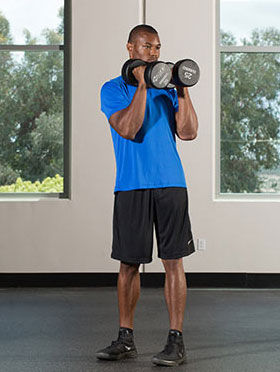
Rotational overhead press
|
|
For plyometric jumps, start with small jumps for sets of two to three reps with at least 45 seconds of rest between each set.
|
During jumps, the contractile element of muscle fibers maintain a contraction while the fascia experiences rapid lengthening and shortening.
|
Jumps-in-place
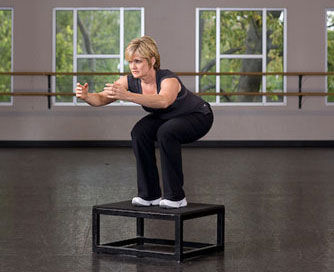
Box jumps (stepping, NOT jumping back down)
Forward jumps
|
|
For kettlebell swings, start with a moderate weight for sets of six to eight reps and work up to sets lasting 30 seconds.
|
The cyclic swinging motion increases the mechanical forces into the fascia of the posterior muscles along the legs and back.
|
2-handed kettlebell swings
|
|
For exercises that involve lunging with arm actions, start with sets of four to six reps on each leg and work up to 10 to 12 on each leg. Rest 45 seconds between sets.
|
Moving the lower- and upper-body segments in opposite directions is an excellent way to load tensile forces into the fascia.
|

Forward lunge with arm drivers
Glute activation lunges
Transverse lunge
|
Programming the Human Machine: Exercising to Strengthen Fascia
If we consider the human body as functioning like a computer, it is important to consider movement as the data that is uploaded to help it function more efficiently. Uploading information to muscle and fascia requires applying the appropriate mechanical forces to have the greatest impact on how the fascia network communicates and transfers information from one section of the body to the next.
When designing a long-term program to enhance the strength and function of fascia, it is possible to alternate workouts between resistance training to improve strength of the contractile element and multiplanar movement training for enhancing loading capabilities of the fascia. An ideal week of training would include two to three days of either strength training for the contractile element combined with two to three days of movement training for the fascia and connective tissue. (Note: Movement training can include dance classes to improve cardiorespiratory efficiency.) Regardless of the focus of the program: To improve strength of the contractile element or function of the fascia, it’s important to have at least one day off from exposing the body to mechanical forces so that it can experience an optimal amount of repair and regeneration.
References
Earls, J. (2014). Born to Walk: Myofascial Efficiency and the Body in Movement. Chichester, England: Lotus Publishing.
Fieldstad, C. et al. (2009). Whole-body vibration augments resistance training effects on body composition in postmenopausal women. Maturitas, 63, 1, 79-83.
Findley, T., Chaudhry, H. and Dhar, S. (2015). Transmission of muscle force to fascia during exercise. Journal of Bodywork and Movement Therapies, 19, 1, 119-123.
Myers, T. (2014). Anatomy Trains: Myofascial Meridians for Manual and Movement Therapists (3rd ed.). London, England: Elsevier.
Schleip, R. (2017). Fascial Fitness: How to be Resilient, Elegant, and Dynamic in Everyday Life and Sport. Chichester, England: Lotus Publishing.
Schleip, R. (2015). Fascia: In Sport and Movement. Edinburgh, Scotland: Handspring Publishing.





 by
by 

 Fascia could be considered a disc drive for the body because it contains numerous sensory receptors that provide important information to the operating system (CNS) about the position and location of various structures of the body as they move. As a form of connective tissue, fascia provides protection, support and structure to the contractile element of muscle tissue, and is an important component of the tissues that make up the tendons that attach muscles to bone, ligaments that connect one bone to another and even the periosteum covering the surface of bone (Schleip, 2017). (Note: While we often perceive bone as a solid structure, keep in mind that it is living tissue in the body, and is therefore more malleable and adapts to mechanical stresses just like other tissues.)
Fascia could be considered a disc drive for the body because it contains numerous sensory receptors that provide important information to the operating system (CNS) about the position and location of various structures of the body as they move. As a form of connective tissue, fascia provides protection, support and structure to the contractile element of muscle tissue, and is an important component of the tissues that make up the tendons that attach muscles to bone, ligaments that connect one bone to another and even the periosteum covering the surface of bone (Schleip, 2017). (Note: While we often perceive bone as a solid structure, keep in mind that it is living tissue in the body, and is therefore more malleable and adapts to mechanical stresses just like other tissues.)  In the body, fibroblasts allow the tissues to function as a self-repairing system.
In the body, fibroblasts allow the tissues to function as a self-repairing system.



